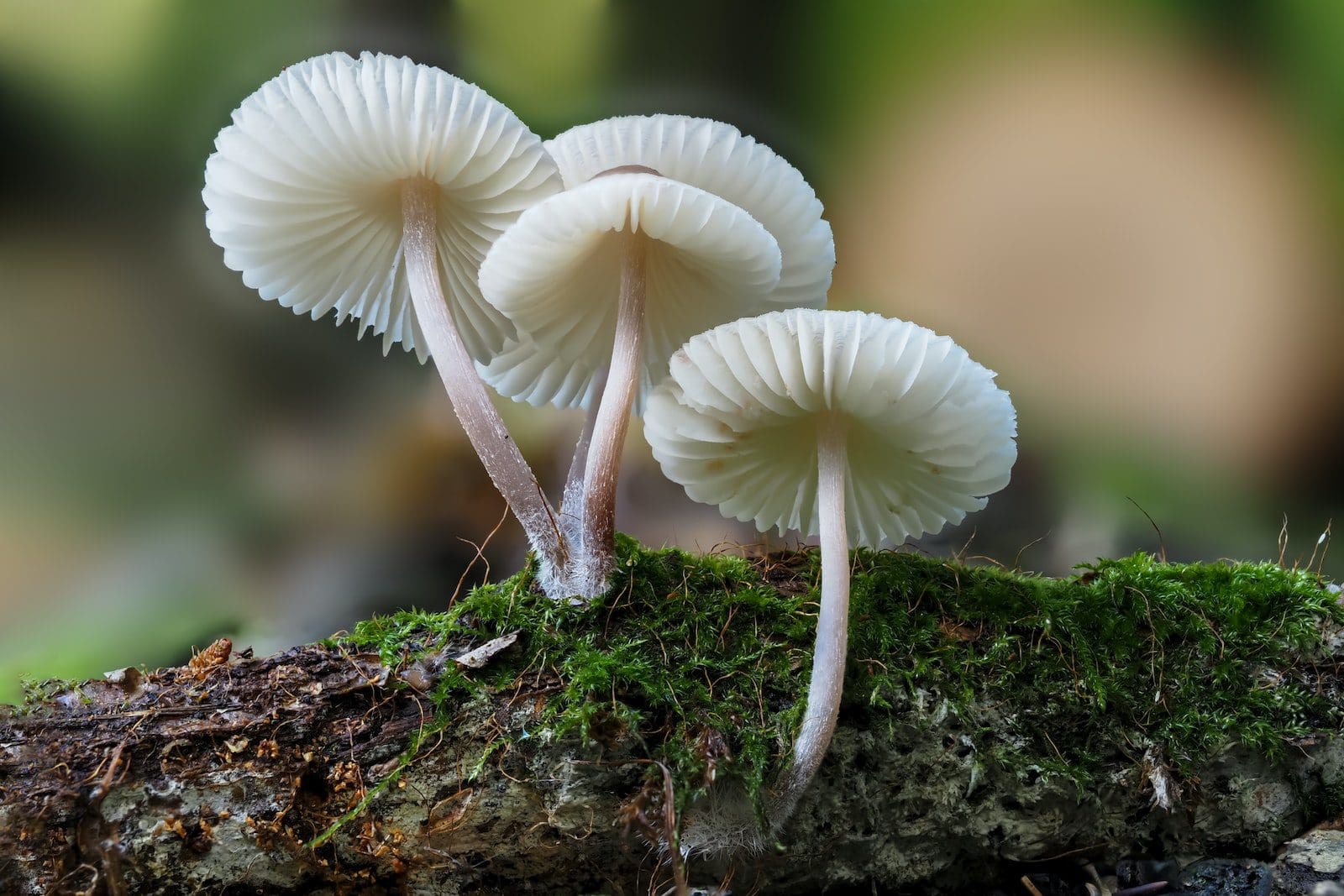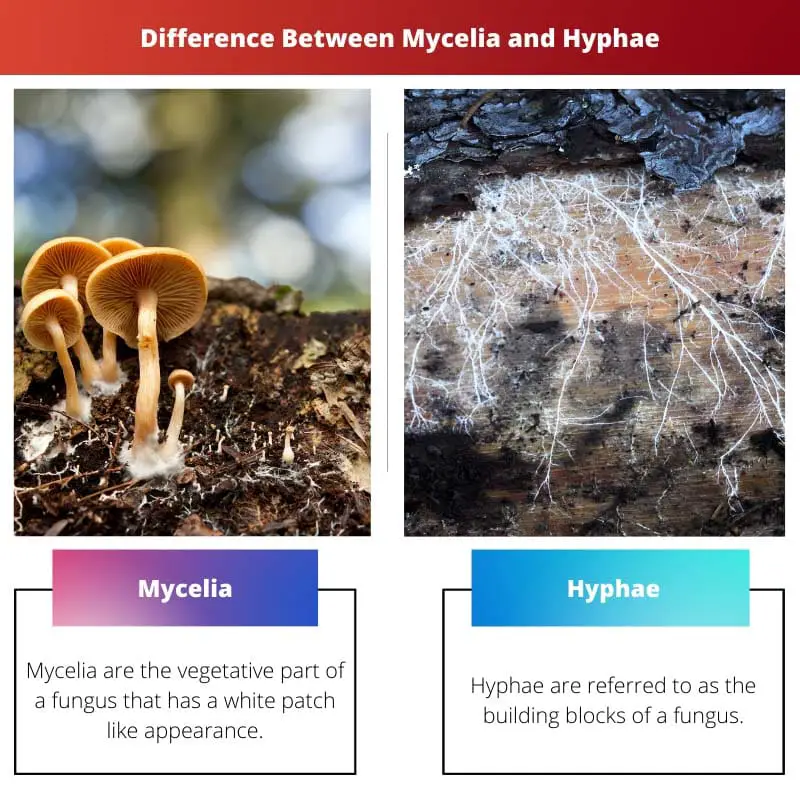Mycelia and hyphae are two parts of a fungus that are interlinked with each other, and their separate meaning is lost to the readers. But their differences are based on the vital roles that each plays in the life of a fungus.
Key Takeaways
- Mycelia are networks of branching, thread-like structures called hyphae.
- Hyphae are single, elongated cells that comprise the mycelium and are responsible for nutrient absorption.
- Both mycelia and hyphae play crucial roles in fungal growth, reproduction, and nutrient cycling in ecosystems.
Mycelia vs Hyphae
Mycelia is a vegetative part of a fungus that looks like a white patch and is created by filamentous hyphae coming together to form a cotton-like structure. Hyphae is the filamentous structure of the fungus that grows into the soil and releases enzymes. It breaks down nutrients and feeds the fungus.

Another critical difference between the two is that mycelia form the vegetative part of the fungus, whereas hyphae form the filamentous part. Hyphae are also sometimes regarded as the building blocks of a fungus.
Mycelia are white thread-like structures formed by the collective hyphae, whereas hyphae are filamentous structures divided into cells by intercross walls called Septa. A crucial difference between Mycelia and hyphae is that mycelia reproduce asexually with the help of spores and sexually in the form of dikaryotic mycelia. In contrast, hyphae grow with the help of spitzenkorper vesicles.
Comparison Table
| Parameter of Comparison | Mycelia | Hyphae |
|---|---|---|
| Functional level | Macro level | Micro level |
| Growth | Sexual and asexual reproduction | With the help of small vesicles called spitzenkorper |
| Appearance | White patch of thread-like structures | Threadlike filaments |
| Part of the plant | Vegetative part | Filamentous part |
| Types | Homokaryotic and dikaryotic mycelia | Septate and aseptate hyphae |
What is Mycelia?
Mycelia are the vegetative part of a fungus with a white patch-like appearance. They are formed by combining the filamentous hyphae and forming a cotton ball-like structure found on or in the soil.
Homokaryotic mycelia reproduce asexually from spores. When two compatible homokaryotic mycelia come together, they form a dikaryotic mycelium capable of producing sexually.
The sexual reproduction of dikaryotic mycelia forms fruits and other fungi that grow above the ground.
Mycelia are responsible for the absorption of nutrients in fungus and their survival. Mycelia grow outwards circular, and as it grows outwards, the insides are left to die since they are depleted of nutrients.
As mycelia grow, they require new fill of nutrients constantly. To facilitate the absorption of nutrients through their pores, they release certain enzymes that break down complex carbohydrates and proteins into simpler ones. These highly branched structures grow and move towards moist areas to sustain survival while constantly breaking down and absorbing nutrients.

What are Hyphae?
Hyphae are referred to as the building blocks of a fungus. They are the filamentous structures that grow into the soil and release enzymes to break down nutrients and absorb them to feed the rest of the fungus.
These white-branched masses spread over the ground and penetrate deep into its substrate to facilitate a nutrient conversion. As hyphae primarily work on the micro-level, it is not visible to the naked eye unless it accumulates and forms mycelia.
Hyphae are separated by septa or septum into cells and grow along the tip with the help of small vesicles called the spitzenkorper. The hyphae cells are enveloped by rigid cell walls that protect them from harsh weather.
The spitzenkorper, German for a pointed body, accumulates at the tip of the hyphae to stimulate its growth. The growth of the hyphae is also governed by environmental factors such as sunlight, moist ground, and the availability of nutrients.
The hyphae separated by septa are called septate hyphae, and the ones missing the septum are called aseptate hyphae. The septa are porous and help pass the absorbed nutrients along the hyphae.

Main Differences Between Mycelia and Hyphae
- The main difference between mycelia and hyphae is that mycelia work on a macro level while hyphae work on a micro level penetrating the substrate and facilitating absorption.
- Another key difference is that mycelia form the vegetative part of the fungus, whereas hyphae form the filamentous part.
- Mycelia reproduce sexually or asexually with the help of spore formation, while hyphae multiply with the help of spitzenkorper.
- Mycelia look like a white patch or a cotton ball, whereas hyphae are thread-like filamentous structures almost invisible to the eye.
- Mycelia may be homokaryotic and dikaryotic, while hyphae are septate or aseptate.

- https://www.sciencedirect.com/science/article/pii/S0966842X0400023X
- https://www.microbiologyresearch.org/content/journal/micro/10.1099/00221287-81-1-225?crawler=true&mimetype=application/pdf

The article lacks a humorous touch in such a technical piece.
These topics are rarely meant to be humorous.
I don’t believe humor is necessary here.
The way the author has put forward the differences between the two is quite stimulating.
Absolutely, the contrasts were neatly presented.
The author’s approach lacks entertainment, but the content is enlightening.
I think the content is more important than entertainment here.
The author could have included more real-life examples to help understand these concepts.
Yes, that would have been very helpful.
The way these two fungi parts are portrayed in the article was very enlightening. Thank you.
I agree, the article was very informative.
Yes, it was very well detailed.
The article lacks a focused structure as it goes deep into the technicalities. It’s hard to keep up.
I believe a lack of scientific knowledge on the subject can make the article hard to understand.
I think it was well-researched.
The author made a complex subject simpler to understand. Great work!
I agree, it was very well explained.
The article was quite technical and complex, requiring a high intellectual level to understand fully.
Yes, the topic is complex for general readers.
The article creates an arguement around this topic which I feel is unnecessary.
I think it was appropriately written.
I believe the contrasts were well done.
The content could be better organized to avoid confusion on such a complex topic.
That’s a valid point.
I think it was fine the way it was.